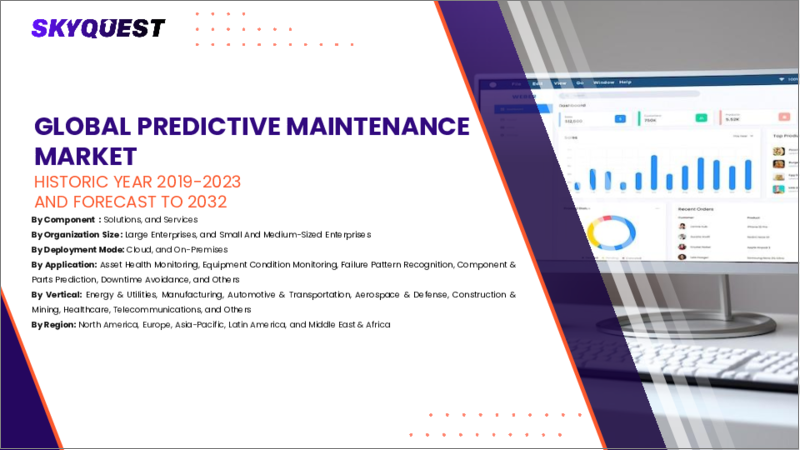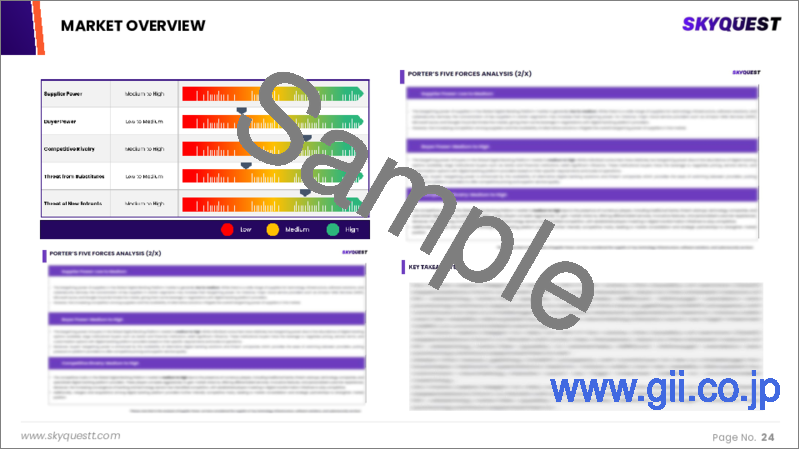|
|
市場調査レポート
商品コード
1689997
予知保全市場の市場規模、シェア、成長分析:コンポーネント別、技術別、組織規模別、業種別、地域別 - 産業予測 2025~2032年Predictive Maintenance Market Size, Share, and Growth Analysis, By Component, By Technology, By Technique, By Organization Size, By Vertical, By Region - Industry Forecast 2025-2032 |
||||||
|
|||||||
| 予知保全市場の市場規模、シェア、成長分析:コンポーネント別、技術別、組織規模別、業種別、地域別 - 産業予測 2025~2032年 |
|
出版日: 2025年03月21日
発行: SkyQuest
ページ情報: 英文 197 Pages
納期: 3~5営業日
|
全表示
- 概要
- 目次
予知保全市場規模は2023年に102億米ドルと評価され、2024年の129億4,000万米ドルから2032年には870億5,000万米ドルに成長し、予測期間(2025-2032年)のCAGRは26.9%で成長する見通しです。
予知保全市場は、最適な効率性と安定性のために特殊な包装を必要とするバイオシミラーや生物製剤の採用が増加していることが主な要因となって、最近大きな成長を遂げています。センサーやRFID技術を組み込んだスマート包装の技術革新は、医薬品の監視・管理を強化し、市場拡大をさらに後押ししています。しかし、厳しい規制要件が包装ソリューションにコストと複雑さをもたらし、市場成長の課題となっています。さらに、先進パッケージングソリューションに関連する高額な経費が市場拡大の妨げとなっています。とはいえ、新興国市場での需要の急増とスマート包装技術の進歩は、予知保全分野の成長機会として有望です。
目次
イントロダクション
- 調査の目的
- 調査範囲
- 定義
調査手法
- 情報調達
- 二次と一次データの方法
- 市場規模予測
- 市場の前提条件と制限
エグゼクティブサマリー
- 世界市場の見通し
- 供給と需要の動向分析
- セグメント別機会分析
市場力学と見通し
- 市場概要
- 市場規模
- 市場力学
- 促進要因と機会
- 抑制要因と課題
- ポーターの分析
主な市場の考察
- 重要成功要因
- 競合の程度
- 主な投資機会
- 市場エコシステム
- 市場の魅力指数(2024年)
- PESTEL分析
- マクロ経済指標
- バリューチェーン分析
- 価格分析
- 特許分析
- 規制分析
- 技術分析
- ケーススタディ
- 顧客と購買基準の分析
- 貿易分析
予知保全市場規模:コンポーネント別& CAGR(2025-2032)
- 市場概要
- ハードウェア
- ソリューション
- 統合型
- スタンドアロン
- ソリューション:展開別
- クラウド
- パブリック
- プライベート
- ハイブリッド
- オンプレミス
- サービス
- プロフェッショナルサービス
- システム統合
- サポートとメンテナンス
- コンサルティング
- マネージドサービス
予知保全市場規模:技術別& CAGR(2025-2032)
- 市場概要
- 分析とデータ管理
- 人工知能
- IoTプラットフォーム
- センサーとその他のデバイス
予知保全市場規模:テクニック別& CAGR(2025-2032)
- 市場概要
- 振動解析
- テストコンポーネントの配置
- 不均衡を検出
- 共鳴の識別
- ギア故障検出
- その他
- 赤外線サーモグラフィー
- 暖房システムの評価
- 流体分析
- 放電パターンを分析する
- 屋根のメンテナンス
- その他
- 音響モニタリング
- パイプライン監視
- コンデンサー評価
- 真空システム監視
- ファンの動作診断
- エアコンプレッサー監視
- その他
- オイル分析
- タービンメンテナンス
- 油圧システムのメンテナンス
- エンジン評価
- トランスミッション評価
- ギア潤滑油レベル監視
- その他
- モーター回路解析
- エンジンの劣化を評価する
- シャフトとローターのアライメント
- 断熱評価
- ギア評価
- 短絡の検知
- その他
- その他のテクニック
予知保全市場規模:組織規模別& CAGR(2025-2032)
- 市場概要
- 大企業
- 中小企業
予知保全市場規模:業界別& CAGR(2025-2032)
- 市場概要
- エネルギー・公益事業
- 製造業
- 自動車・輸送
- 航空宇宙・防衛
- 建設・鉱業
- ヘルスケア
- 通信
- その他の業種
予知保全市場規模:地域別& CAGR(2025-2032)
- 北米
- 米国
- カナダ
- 欧州
- ドイツ
- スペイン
- フランス
- 英国
- イタリア
- その他欧州地域
- アジア太平洋地域
- 中国
- インド
- 日本
- 韓国
- その他アジア太平洋地域
- ラテンアメリカ
- ブラジル
- その他ラテンアメリカ地域
- 中東・アフリカ
- GCC諸国
- 南アフリカ
- その他中東・アフリカ
競合情報
- 上位5社の比較
- 主要企業の市場ポジショニング(2024年)
- 主な市場企業が採用した戦略
- 最近の市場動向
- 企業の市場シェア分析(2024年)
- 主要企業の企業プロファイル
- 企業の詳細
- 製品ポートフォリオ分析
- 企業のセグメント別シェア分析
- 収益の前年比比較(2022-2024)
主要企業プロファイル
- IBM Corporation(USA)
- SAP SE(Germany)
- General Electric(USA)
- Schneider Electric(France)
- Hitachi, Ltd.(Japan)
- PTC, Inc.(USA)
- SAS Institute, Inc.(USA)
- C3.ai, Inc.(USA)
- Uptake Technologies Inc.(USA)
- Microsoft Corporation(USA)
- ABB Ltd.(Switzerland)
- Rockwell Automation, Inc.(USA)
- Siemens AG(Germany)
- Emerson Electric Co.(USA)
- Oracle Corporation(USA)
- Bosch Software Innovations GmbH(Germany)
- SKF AB(Sweden)
- Honeywell International Inc.(USA)
結論と提言
Predictive Maintenance Market size was valued at USD 10.2 billion in 2023 and is poised to grow from USD 12.94 billion in 2024 to USD 87.05 billion by 2032, growing at a CAGR of 26.9% during the forecast period (2025-2032).
The Predictive Maintenance market has seen significant growth recently, largely driven by the increasing adoption of biosimilars and biologics, which require specialized packaging for optimal efficiency and stability. Innovations in smart packaging, incorporating sensors and RFID technology, have enhanced monitoring and management of pharmaceutical products, further propelling market expansion. However, stringent regulatory requirements add cost and complexity to packaging solutions, posing a challenge to market growth. Additionally, the high expenses associated with advanced packaging solutions hinder progress. Nonetheless, the burgeoning demand in developing markets and advancements in smart packaging technologies present promising opportunities for growth in the Predictive Maintenance sector.
Top-down and bottom-up approaches were used to estimate and validate the size of the Predictive Maintenance market and to estimate the size of various other dependent submarkets. The research methodology used to estimate the market size includes the following details: The key players in the market were identified through secondary research, and their market shares in the respective regions were determined through primary and secondary research. This entire procedure includes the study of the annual and financial reports of the top market players and extensive interviews for key insights from industry leaders such as CEOs, VPs, directors, and marketing executives. All percentage shares split, and breakdowns were determined using secondary sources and verified through Primary sources. All possible parameters that affect the markets covered in this research study have been accounted for, viewed in extensive detail, verified through primary research, and analyzed to get the final quantitative and qualitative data.
Predictive Maintenance Market Segments Analysis
Global Predictive Maintenance Market is segmented by Component, Technology, Technique, Organization Size, Vertical and region. Based on Component, the market is segmented into Hardware, Solutions, Solutions By Deployment Mode and Services. Based on Technology, the market is segmented into Analytics & Data Management,Artificial Intelligence, Iot Platform and Sensors & Other Devices. Based on Technique, the market is segmented into Vibration Analysis, Infrared Thermography, Acoustic Monitoring, Oil Analysis, Motor Circuit Analysis and Other Techniques. Based on Organization Size, the market is segmented into Large Enterprises and Small And Medium-Sized Enterprises. Based on Vertical, the market is segmented into Energy & Utilities, Manufacturing, Automotive & Transportation, Aerospace & Defense, Construction & Mining, Healthcare, Telecommunications and Other Verticals. Based on region, the market is segmented into North America, Europe, Asia Pacific, Latin America and Middle East & Africa.
Driver of the Predictive Maintenance Market
The surge in the deployment of sensors and IoT devices facilitates real-time monitoring and data collection, which is crucial for effective predictive maintenance, thereby propelling market growth. Additionally, advancements in machine learning algorithms and sophisticated data analytics enhance the ability to anticipate equipment failures by analyzing vast amounts of data. This leads to more accurate predictions and actionable insights, further driving the demand for predictive maintenance solutions. As industries continue to embrace these technologies, the market for predictive maintenance is expected to expand significantly, driven by the need for operational efficiency and reduced downtime.
Restraints in the Predictive Maintenance Market
The predictive maintenance market faces significant challenges due to the high costs associated with implementing such solutions. The substantial initial investments required for sensors, technology, and software create barriers, particularly for medium-sized and small enterprises. Additionally, the scarcity of skilled professionals capable of effectively managing and analyzing predictive maintenance systems further hinders market expansion. This combination of financial constraints and a shortage of expertise can limit the adoption of predictive maintenance strategies, ultimately impacting the growth potential of the market as a whole. Addressing these issues is essential for fostering broader acceptance and implementation across various industries.
Market Trends of the Predictive Maintenance Market
The burgeoning trend of Predictive Maintenance-as-a-Service (PdMaaS) is revolutionizing the maintenance landscape, offering organizations enhanced access to predictive technologies and analytics through cloud-enabled solutions. This democratization allows businesses, regardless of size, to leverage predictive algorithms without the hefty investment in infrastructure, enabling streamlined operations and cost reductions. By outsourcing predictive maintenance functions to specialized providers, organizations can focus on their core competencies, driving efficiency and productivity. As industries increasingly recognize the strategic advantages of PdMaaS, the market is expected to witness robust growth, fueled by an accelerated shift towards data-driven maintenance strategies and the rising demand for operational excellence.
Table of Contents
Introduction
- Objectives of the Study
- Scope of the Report
- Definitions
Research Methodology
- Information Procurement
- Secondary & Primary Data Methods
- Market Size Estimation
- Market Assumptions & Limitations
Executive Summary
- Global Market Outlook
- Supply & Demand Trend Analysis
- Segmental Opportunity Analysis
Market Dynamics & Outlook
- Market Overview
- Market Size
- Market Dynamics
- Drivers & Opportunities
- Restraints & Challenges
- Porters Analysis
- Competitive rivalry
- Threat of substitute
- Bargaining power of buyers
- Threat of new entrants
- Bargaining power of suppliers
Key Market Insights
- Key Success Factors
- Degree of Competition
- Top Investment Pockets
- Market Ecosystem
- Market Attractiveness Index, 2024
- PESTEL Analysis
- Macro-Economic Indicators
- Value Chain Analysis
- Pricing Analysis
- Patent Analysis
- Regulatory Analysis
- Technology Analysis
- Case Studies
- Customer And Buying Criteria Analysis
- Trade Analysis
Global Predictive Maintenance Market Size by Component & CAGR (2025-2032)
- Market Overview
- Hardware
- Solutions
- Integrated
- Standalone
- Solutions By Deployment Mode
- Cloud
- Public
- Private
- Hybrid
- On-Premises
- Services
- Professional Services
- System Integration
- Support & Maintenance
- Consulting
- Managed Services
Global Predictive Maintenance Market Size by Technology & CAGR (2025-2032)
- Market Overview
- Analytics & Data Management
- Artificial Intelligence
- Iot Platform
- Sensors & Other Devices
Global Predictive Maintenance Market Size by Technique & CAGR (2025-2032)
- Market Overview
- Vibration Analysis
- Test Component Alignment
- Detect Imbalances
- Resonance Identification
- Gear Failure Detection
- Others
- Infrared Thermography
- Assess Heating Systems
- Fluid Analysis
- Analyze Discharge Patterns
- Roof Maintenance
- Others
- Acoustic Monitoring
- Pipeline Monitoring
- Condenser Evaluation
- Vacuum System Monitoring
- Fan Health Assessment
- Air Compressor Monitoring
- Others
- Oil Analysis
- Turbine Maintenance
- Hydraulic System Maintenance
- Engine Evaluation
- Transmission Assessment
- Gear Lubricant Level Monitoring
- Others
- Motor Circuit Analysis
- Assess Engine Degradation
- Shaft And Rotor Alignment
- Insulation Evaluation
- Gear Assessment
- Scan For Short Circuits
- Others
- Other Techniques
Global Predictive Maintenance Market Size by Organization Size & CAGR (2025-2032)
- Market Overview
- Large Enterprises
- Small And Medium-Sized Enterprises
Global Predictive Maintenance Market Size by Vertical & CAGR (2025-2032)
- Market Overview
- Energy & Utilities
- Manufacturing
- Automotive & Transportation
- Aerospace & Defense
- Construction & Mining
- Healthcare
- Telecommunications
- Other Verticals
Global Predictive Maintenance Market Size & CAGR (2025-2032)
- North America (Component, Technology, Technique, Organization Size, Vertical)
- US
- Canada
- Europe (Component, Technology, Technique, Organization Size, Vertical)
- Germany
- Spain
- France
- UK
- Italy
- Rest of Europe
- Asia Pacific (Component, Technology, Technique, Organization Size, Vertical)
- China
- India
- Japan
- South Korea
- Rest of Asia-Pacific
- Latin America (Component, Technology, Technique, Organization Size, Vertical)
- Brazil
- Rest of Latin America
- Middle East & Africa (Component, Technology, Technique, Organization Size, Vertical)
- GCC Countries
- South Africa
- Rest of Middle East & Africa
Competitive Intelligence
- Top 5 Player Comparison
- Market Positioning of Key Players, 2024
- Strategies Adopted by Key Market Players
- Recent Developments in the Market
- Company Market Share Analysis, 2024
- Company Profiles of All Key Players
- Company Details
- Product Portfolio Analysis
- Company's Segmental Share Analysis
- Revenue Y-O-Y Comparison (2022-2024)
Key Company Profiles
- IBM Corporation (USA)
- Company Overview
- Business Segment Overview
- Financial Updates
- Key Developments
- SAP SE (Germany)
- Company Overview
- Business Segment Overview
- Financial Updates
- Key Developments
- General Electric (USA)
- Company Overview
- Business Segment Overview
- Financial Updates
- Key Developments
- Schneider Electric (France)
- Company Overview
- Business Segment Overview
- Financial Updates
- Key Developments
- Hitachi, Ltd. (Japan)
- Company Overview
- Business Segment Overview
- Financial Updates
- Key Developments
- PTC, Inc. (USA)
- Company Overview
- Business Segment Overview
- Financial Updates
- Key Developments
- SAS Institute, Inc. (USA)
- Company Overview
- Business Segment Overview
- Financial Updates
- Key Developments
- C3.ai, Inc. (USA)
- Company Overview
- Business Segment Overview
- Financial Updates
- Key Developments
- Uptake Technologies Inc. (USA)
- Company Overview
- Business Segment Overview
- Financial Updates
- Key Developments
- Microsoft Corporation (USA)
- Company Overview
- Business Segment Overview
- Financial Updates
- Key Developments
- ABB Ltd. (Switzerland)
- Company Overview
- Business Segment Overview
- Financial Updates
- Key Developments
- Rockwell Automation, Inc. (USA)
- Company Overview
- Business Segment Overview
- Financial Updates
- Key Developments
- Siemens AG (Germany)
- Company Overview
- Business Segment Overview
- Financial Updates
- Key Developments
- Emerson Electric Co. (USA)
- Company Overview
- Business Segment Overview
- Financial Updates
- Key Developments
- Oracle Corporation (USA)
- Company Overview
- Business Segment Overview
- Financial Updates
- Key Developments
- Bosch Software Innovations GmbH (Germany)
- Company Overview
- Business Segment Overview
- Financial Updates
- Key Developments
- SKF AB (Sweden)
- Company Overview
- Business Segment Overview
- Financial Updates
- Key Developments
- Honeywell International Inc. (USA)
- Company Overview
- Business Segment Overview
- Financial Updates
- Key Developments





